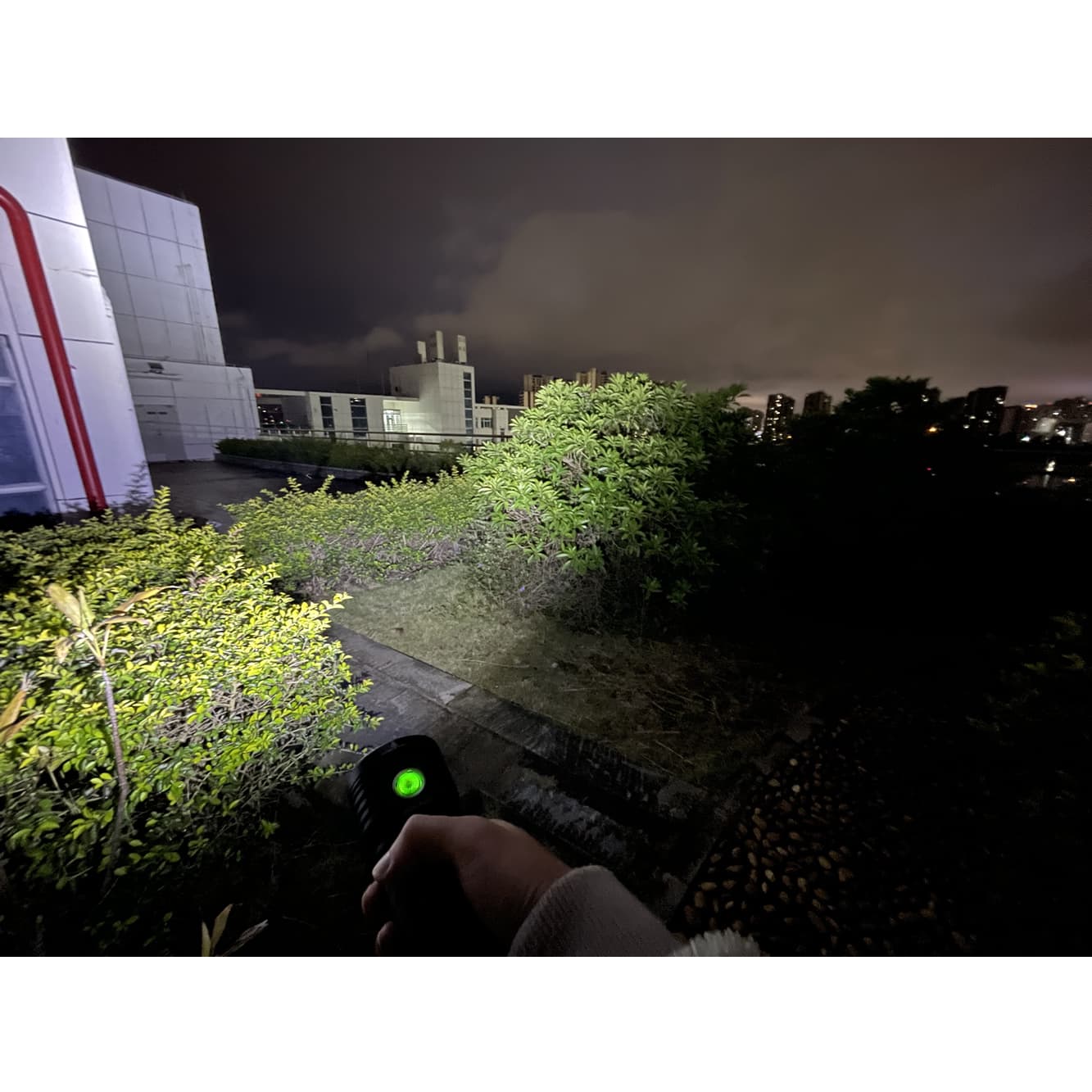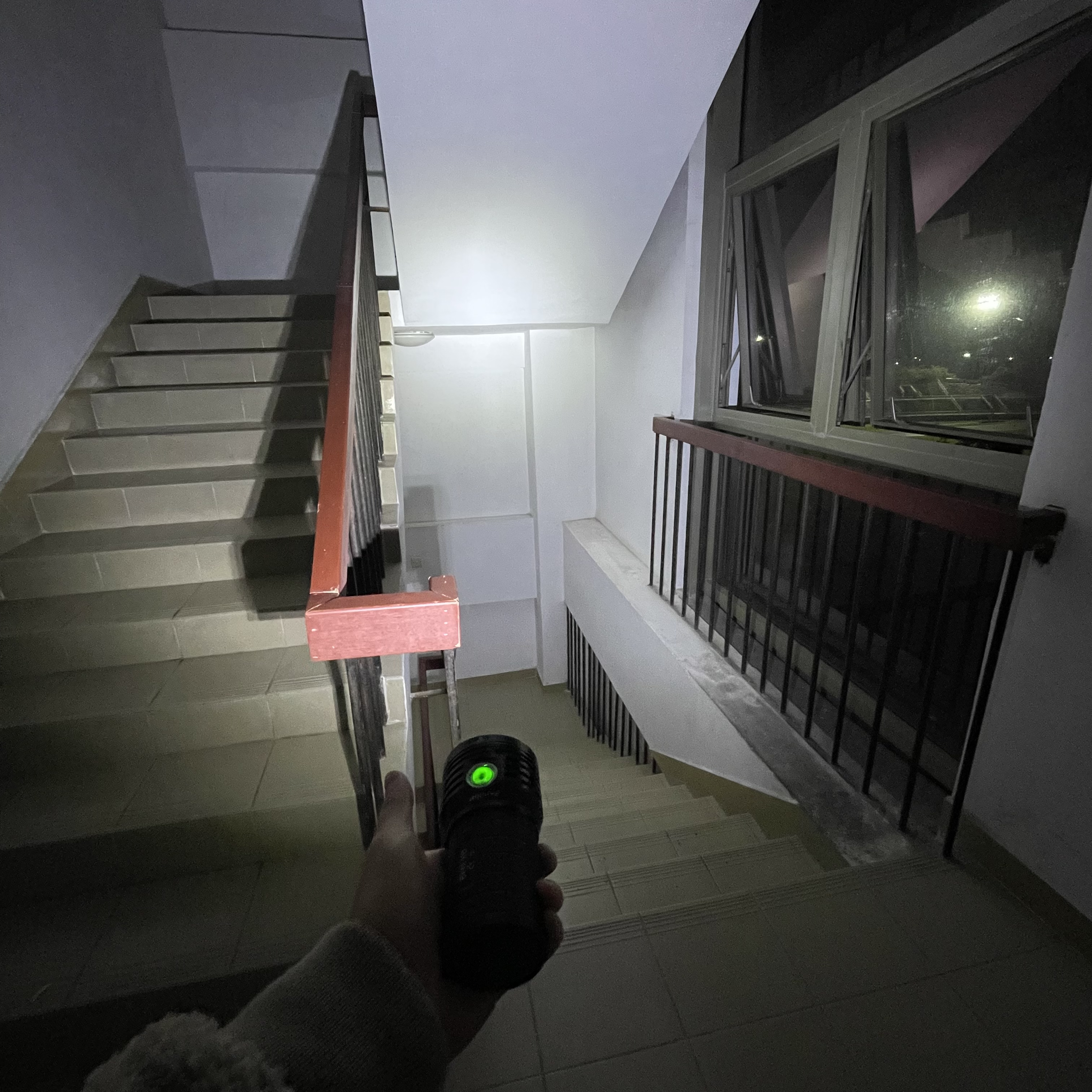How to Choose a Flashlight for Professional Construction or Industrial Use

Choosing a flashlight for professional construction or industrial use is more than just picking a light source. The right flashlight ensures safety in challenging environments, where visibility and reliability are critical. A poorly chosen flashlight can fail during crucial tasks, putting you and your team at risk. For example, durable flashlights reduce failures, while rechargeable models can save over $200 per unit annually. Reliable lighting improves performance and keeps your work environment safe. By understanding how to choose a flashlight, you can enhance efficiency and productivity while ensuring a safe flashlight meets your needs.
Feature | Importance |
|---|---|
Durability | Reduces risk of failure during critical tasks. |
Cost-effectiveness | High-quality flashlights save money in the long run by reducing replacements. |
Rechargeable benefits | Switching to rechargeable models saved a manufacturer over $200 per flashlight in the first year. |
Safety and efficiency | Ensures safety and efficiency with features like brightness and waterproofing. |
Performance improvement | Reliable flashlights enhance work performance and reduce risks. |
Key Takeaways
Pick a strong flashlight to avoid it breaking during work. A good flashlight keeps you safe and helps you work better.
Choose the right brightness for your job. For normal tasks, use 200-300 lumens. For detailed work, go for 500-1000 lumens.
Make sure the flashlight has safety labels like Class or Division. These show it’s safe to use in risky places.
Think about rechargeable flashlights to save money and help the planet. They last longer and make less trash.
Check the IP rating to see if it blocks water and dust. A high rating means it can handle tough jobs.
Key Features to Consider
Brightness and Beam Options
Lumens and visibility for professional tasks.
When choosing a flashlight for professional use, brightness plays a critical role. The brightness of a flashlight is measured in lumens, which determines how much light it emits. Different tasks require varying levels of brightness to ensure optimal visibility. For instance, simple assembly work may only need 200-300 lux, while precision tasks like manual arc welding demand 5,000-7,500 lux. Below is a table to help you match brightness levels to specific tasks:
Task Type | Recommended Lux Levels |
|---|---|
Assembly Work (Simple) | 200-300 lux |
Assembly Work (Difficult) | 1,000-1,500 lux |
Paint Booth (Fine Hand Painting) | 1,000-1,500 lux |
Precision Manual Arc Welding | 5,000-7,500 lux |
Selecting the right brightness ensures you can work efficiently and safely, even in challenging environments.
Spot vs. flood beam patterns.
The beam pattern of your flashlight affects how light is distributed. Spot beams provide a narrow, focused light, making them ideal for long-range visibility or precise tasks. On the other hand, flood beams spread light over a wider area, perfect for illuminating large spaces like worksites. For example, in automotive settings, spot beams help you identify obstacles from a distance, while flood beams are better for lighting up campsites or loading docks. Understanding these differences helps you choose the right beam pattern for your specific needs.
Color Temperature and Eye Comfort
Warm vs. cool light for different environments.
The color temperature of a flashlight impacts how comfortable it is to use in various settings. Warm light, which has a yellowish hue, works well in dim environments and reduces glare. Cool light, with its bluish tone, enhances visibility in brightly lit areas or outdoors. Choosing the right color temperature ensures you can adapt to your work environment without straining your eyes.
Reducing eye strain during prolonged use.
Prolonged use of a flashlight can lead to eye fatigue, especially in low-light conditions. To minimize strain, opt for an LED flashlight with adjustable brightness and a comfortable color temperature. This feature allows you to customize the light output based on your task, ensuring better focus and reduced discomfort during extended work hours.
Stabilization and Heat Management
Consistent brightness over time.
A reliable flashlight maintains consistent brightness throughout its runtime. This feature, known as stabilization, ensures that the light output does not dim as the battery drains. Consistent brightness is crucial for tasks requiring steady illumination, such as inspecting machinery or performing detailed work.
Preventing overheating in extended use.
Flashlights can overheat during prolonged use, which may affect performance and safety. To prevent this, follow best practices like limiting continuous use and allowing the flashlight to cool periodically. Models with built-in thermal regulation systems are particularly effective, as they automatically manage heat levels. Keeping ventilation ports clear also helps maintain optimal performance.
Safety Standards for a Safe Flashlight
Hazardous Environment Ratings
Class, Division, and Group ratings.
When working in a hazardous location, understanding the classification system for flashlights is essential. These ratings help you determine whether a flashlight is safe for specific environments. The system categorizes hazardous locations into three classes based on the type of material present:
Class | Description | Examples |
|---|---|---|
Class I | Flammable Gases, Vapors, or Liquids | Oil refineries, offshore oil rigs |
Class II | Combustible Dusts | Coal mines, grain silos |
Class III | Ignitable Fibers and Flyings | Paper mills, textile mills |
Each class ensures that you select a flashlight designed to handle the specific risks of your work environment. For example, a Class I flashlight is ideal for areas with flammable gases, while a Class II flashlight suits locations with combustible dust.
Ignition temperature considerations.
Flashlights used in hazardous locations must meet strict safety requirements to prevent ignition of hazardous materials. The maximum surface temperature of the flashlight must remain below the minimum ignition temperature of the materials present. This ensures that the flashlight does not become a source of ignition. Temperature ratings, categorized from T1 (450°C) to T6 (85°C), indicate the maximum allowable surface temperature. Always verify the temperature rating of your flashlight to match the ignition risks in your environment. This step minimizes the chance of accidents and ensures compliance with safety standards.
Industry Compliance
ANSI/PLATO FL1 standards.
The ANSI/PLATO FL1 standards provide a consistent method for measuring flashlight performance. These standards ensure that you can compare flashlights based on key features like brightness, runtime, and beam distance. By choosing a flashlight that meets these standards, you gain confidence in its reliability and suitability for professional use.
Importance of third-party certifications.
Third-party certifications enhance the credibility and safety of flashlights used in industrial settings. Certified flashlights undergo rigorous testing to meet stricter safety requirements. Regular unannounced inspections ensure ongoing compliance. This reliability builds trust and ensures that your flashlight performs consistently in hazardous environments. Certifications also indicate that the product has a superior track record, making it a dependable choice for your work.
Durability and Build Quality

Rugged Materials and Construction
Aluminum vs. polymer bodies.
The material of a flashlight’s body determines its durability and suitability for professional use. Aluminum alloy is lightweight and excellent at conducting heat, making it ideal for high-quality flashlights used in outdoor or industrial settings. Polymers, such as Acrylonitrile Butadiene Styrene (ABS), offer chemical resistance and withstand high temperatures, making them a reliable choice for hazardous environments. Below is a comparison of common materials used in flashlight construction:
Material | Properties | Uses in Flashlight Housing |
|---|---|---|
Acrylonitrile Butadiene Styrene (ABS) | Durable, chemical-resistant, heat-tolerant | Plastic polymer flashlights for tough tasks |
Aluminum Alloy | Lightweight, heat-conductive | Outdoor and industrial flashlights |
Stainless Steel | Strong, corrosion-resistant | Heavy-duty flashlights for hazardous areas |
Titanium | High strength-to-weight ratio, corrosion-resistant | Premium flashlights for extreme conditions |
Polymers (e.g., Polystyrene) | Versatile, cost-effective | Budget-friendly flashlights |
Corrosion resistance for harsh conditions.
Corrosion resistance is critical for flashlights used in wet or salty environments. Materials like stainless steel, aluminum, and titanium prevent rust and damage, ensuring reliable performance. Sealed components protect internal parts from moisture, while resistance to saltwater and extreme temperatures enhances functionality. This durability reduces the need for frequent replacements, providing long-term value in hazardous conditions.
Water and Impact Resistance
IP ratings for water and dust protection.
IP ratings measure a flashlight’s ability to resist water and dust. The first digit indicates protection against solids, ranging from no protection to complete dust tightness. The second digit shows water resistance, from no protection to continuous immersion. For hazardous worksites, choose a flashlight with a high IP rating to ensure it performs reliably in challenging environments.
Drop test ratings for durability.
Flashlights undergo rigorous drop tests to ensure they can withstand impacts. These tests simulate real-world conditions, such as drops onto concrete. For example:
Drop Height | Surface | Conditions | Result |
|---|---|---|---|
1 meter | Concrete | All parts included | Must remain functional |
18 ft | Concrete | All parts included | Must remain functional |
6 ft | Concrete | All parts included | Must remain functional |
30 ft | Concrete | All parts included | Must remain functional |
Metal stairs | Varies | Firefighter lanterns | Must remain functional |
These ratings ensure your flashlight can handle the demands of hazardous environments without compromising performance.
Power Source and Battery Options
Battery Life and Efficiency
Runtime for long work shifts.
Battery life plays a crucial role in ensuring uninterrupted work during long shifts. Industrial flashlights often feature extended runtimes to meet the demands of professional tasks. Models equipped with lithium-ion batteries provide consistent performance, making them ideal for high-demand environments. Always check the runtime specifications to ensure the flashlight can last through your work hours without interruptions.
Several factors influence battery life:
Usage: Frequent use drains the battery faster.
Temperature: Extreme heat or cold can reduce battery performance and lifespan.
Charging habits: Overcharging or completely draining the battery can shorten its overall lifespan.
By understanding these factors, you can maximize the efficiency of your flashlight and ensure it performs reliably during extended use.
Balancing brightness with battery life.
High brightness levels often consume more power, reducing battery life. To strike a balance, choose a flashlight with adjustable brightness settings. This feature allows you to lower the brightness when full power isn’t necessary, conserving energy. Flashlights with energy-efficient LEDs also help extend battery life without compromising performance.
Rechargeable vs. Disposable Batteries
Pros and cons of each type.
Choosing between rechargeable and disposable batteries depends on your specific needs. Here’s a comparison to help you decide:
Pros of Rechargeable Batteries | Cons of Rechargeable Batteries |
|---|---|
Higher power capacity for high-drain devices | Can be bulkier than disposable batteries |
Cheaper in the long run due to fewer replacements | Requires charging to function |
More environmentally friendly due to longer lifespan | Initial cost is higher than AA batteries |
Compatibility with standard batteries.
Professional flashlights often support a variety of battery types. Here’s a quick guide to common options:
Battery Type | Description | Use Case |
|---|---|---|
14500 | Compact lithium-ion, similar to AA, offers power boost | Compact or EDC flashlights |
18650 | Common high-performance battery, versatile | Wide range of flashlight applications |
CR123a | Popular lithium battery, good size-power balance | Tactical and emergency flashlights |
NiMH | Rechargeable, available in AA and AAA sizes | Users wanting rechargeable options |
Understanding compatibility ensures you select batteries that match your flashlight and work requirements.
Charging and Backup Options
USB charging vs. charging docks.
Modern flashlights often feature USB charging ports, offering convenience and compatibility with standard cables. This option works well for on-the-go charging. Charging docks, on the other hand, provide a dedicated station for recharging multiple flashlights simultaneously. These docks are ideal for team-based operations where multiple units need charging at once.
Backup power for remote worksites.
For remote worksites, backup power options are essential. Carrying spare batteries or using flashlights with dual power sources ensures you’re never left in the dark. Some models even support power banks, allowing you to recharge your flashlight in the field. These features provide peace of mind and ensure uninterrupted lighting in critical situations.
Specialized Features for Professional Construction or Industrial Use
Hands-Free Operation
Headlamps and helmet-mounted options.
For tasks requiring both hands, headlamps or helmet-mounted flashlights are invaluable. These options provide consistent illumination while keeping your hands free for tools or equipment. Headlamps often come with adjustable straps, ensuring a secure fit for extended use. Helmet-mounted flashlights attach directly to safety helmets, making them ideal for construction sites or hazardous environments. This setup ensures you maintain visibility without compromising safety or efficiency.
Magnetic bases and clips.
Magnetic bases and clips offer versatile mounting solutions for flashlights. A magnetic base allows you to attach the flashlight to metal surfaces, such as machinery or scaffolding, providing stable lighting in hazardous areas. Clips, on the other hand, let you secure the flashlight to belts, pockets, or toolboxes for easy access. These features enhance convenience and ensure your flashlight is always within reach when needed.
Adjustable Focus and Optics
Zoomable flashlights for precision.
Zoomable flashlights adapt to various lighting needs by adjusting the beam width and focus. They provide a narrow, intense beam for long-distance tasks, such as inspecting hazardous equipment. A wider beam works well for general lighting, making these flashlights versatile for both precision tasks and broader applications like outdoor projects or workspace illumination.
Benefits of zoomable flashlights:
Adjust beam width for different tasks.
Narrow beam for long-distance precision.
Wide beam for general lighting needs.
Optics for tight spaces.
Specialized optics improve visibility in confined or tight spaces. Flashlights with focused optics direct light precisely where needed, reducing glare and enhancing clarity. This feature proves essential for inspecting machinery, wiring, or other components in hazardous and hard-to-reach areas.
Compact and Lightweight Designs
Flashlights for portability and ease of use.
Compact and lightweight flashlights simplify portability without sacrificing performance. These models are easy to carry and store, making them ideal for professionals who frequently move between hazardous worksites. A flashlight with at least 500 lumens ensures sufficient brightness for tactical or industrial applications.
Compatibility with protective gear.
Flashlights designed for professional use often integrate seamlessly with protective gear. Compact designs fit into tool belts or safety vests, while lightweight models reduce fatigue during extended use. Durable construction ensures these flashlights withstand hazardous conditions, including impacts and exposure to water or dust.
Choosing the right flashlight for professional construction or industrial use requires careful consideration of safety, durability, and functionality. Assess your work environment by focusing on key factors like safety certifications, durability, lighting technology, and battery life. Always check specifications to ensure the flashlight meets your needs. Conduct pre-production safety checks and post-production testing to verify performance. Integrating user feedback helps improve flashlight designs. By aligning your flashlight choice with your specific requirements, you enhance safety, efficiency, and productivity in demanding environments.
FAQ
What is the ideal brightness level for a construction flashlight?
The ideal brightness depends on your task. For general work, 200-300 lumens work well. For detailed tasks or large areas, choose 500-1000 lumens. Always match the brightness to your environment for optimal visibility.
How do I know if a flashlight is safe for hazardous environments?
Look for safety ratings like Class, Division, and Group classifications. Check for certifications such as ANSI/PLATO FL1. These ensure the flashlight meets safety standards for specific hazardous conditions.
Should I choose a rechargeable flashlight or one with disposable batteries?
Rechargeable flashlights save money over time and are eco-friendly. Disposable batteries offer convenience in remote areas. Choose based on your worksite needs and access to charging options.
What does an IP rating mean for a flashlight?
An IP rating measures protection against dust and water. For example, IP67 means the flashlight is dust-tight and can handle temporary water immersion. Higher ratings ensure better durability in tough environments.
Can I use a compact flashlight for industrial tasks?
Yes, compact flashlights work well if they meet industrial standards. Look for models with high lumens, durable materials, and safety certifications. Compact designs also improve portability and ease of use.
See Also
Selecting the Perfect Headlamp Flashlight for Your Needs
Finding the Ideal High Power Flashlight for You
A Complete Guide to Selecting Your Home Flashlight
The Homeowner's Guide to Picking the Best Emergency Flashlight
